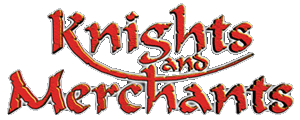Development History
The Shattered Kingdom - Features
In addition to just different units and buildings there were also a lot of interesting features that were being considered to be added into the game. Some of these ideas might have improved the game whilst from others it's clear why the feature was removed. Anyways, it can be quite interesting to get a look at what kind of gameplay elements were being considered for the game.
Gameplay
| Experience Points |
There were originally plans to make soldiers earn experience points when in battle. An alternate way for soldiers to gain experience was to send them to the training hall. How exactly experience points were supposed to improve troops is not known. |
 Fog of War |
In early versions of the game, there was fog of war present in the game. The feature was removed because Adam Sprys felt that it hindered the tactical elements of the game as the fog meant that you had to guess where it would be most prudent to place your units. |
| More Maps |
Originally plans were to include a lot more maps with the game than what actually shipped. The menu was to allow you to choose different campaigns, launch single missions (a la The Peasants Rebellion) and also have different kinds of battle missions ready to launch straight from the main menu. |
| Extra Multiplayer Maps |
There were plans for extra multiplayer maps to be released for the game after the game itself had actually been released. Exactly how these would've been distributed is not known, but most likely they would have either been released on the official website or through cover discs included with gaming magazines. As such the game still supports adding multiplayer maps into the game simply by adding a new mmissionx.dat into the mission folder. |
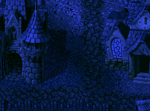 Night |
A most interesting gameplay element; at one point during the development there was nighttime as a gameplay element. During night your serfs had to find themselves a house to sleep in. This didn't work out as it was more of an annoyance since defending ones camp became very difficult during nights. |
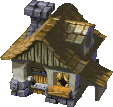 Housing |
When the nighttime element didn't work out, another attempt was made where houses were to be used to increase the limit of your population (a la Age of Empires). This didn't work out either since the amount of houses you needed took up ways too much valuable building space. |
Interface
| Game View Scrolling |
Originally, you were not able to scroll the game view by taking the mouse cursor to the edge of the screen. Instead, the only ways that you could scroll the game view were to use the arrow keys, press the right mouse button and then move the mouse or by clicking somewhere on the mini-map. It sure made the gameplay more frustrating. |
| Controlling Military |
Using the mouse keys to control military and their movement was originally not possible. Instead you had to rely on using the buttons that were present in the military control interface to both move your troops and to task them to attack something. |
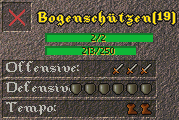 Detailed Soldier Stats |
In the final version of the game, the only stats that are shown are those on the parchment graphic. These are far from complete and in certain cases not all that accurate either. Originally you were able to see the exact stats of an unit when it was selected. Why this was removed is not known, but perhaps it was thought the game would feel more realistic if these stats were hidden? |
Feed Troop Cursor |
Why exactly this troop exists is not completely clear to me, but it seems that there was originally no button in the soldier interface to feed troops. Perhaps you were supposed to click on some button in either the inn or the storehouse which then allowed you to choose troops that you wanted to feed? |
| Messages Menu |
There were originally plans to have multiplayer messages shown under a menu option like the building selection and statistics menus. This was understandably changed since it would have meant some quite major interface differences between single player and multiplayer games. |
Destruct Button |
Originally, houses had a big destruct button on the bottom part of their interface which allowed you to destroy any buildings you felt were unnecessary. As such, the red X that is present in the final version of the game in the building selection did not exist. |
| MIDI Music |
There were plans to include both MIDI and CD audio music with the retail version of the game. This was understandably dropped as you were required to have the game CD inserted in your drive so the CD audio was always useable. |
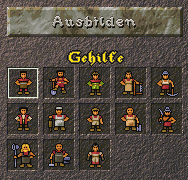 Schoolhouse Menu |
The schoolhouse used to have a completely unique system for training citizens during development. Basically you had to choose which citizen you wanted to train by clicking on the small icons and then click on the train button, which in turn would start the training process. In addition, you also had to unlock all the citizens before you could train them. They were unlocked once you had built any building in which that were citizen worked. This system didn't allow queuing of citizens, so training a lot of serfs could be quite the process. |
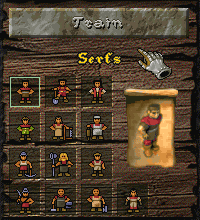 Schoolhouse Menu |
This is a somewhat later revision of the schoolhouse system. The only real difference here is that the parchment graphic for the citizen is also visible in this version of the system. |
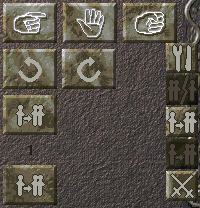 Soldier Menu |
This is an earlier version of the soldier control interface. The layout is definitely a lot more confusing than that of the final version, so it was definitely a good thing that it was made more compact later on. Something else interesting is that the formations were shown simply as numbers, with the number telling how many lines there were in a formation. A fact worth pointing out is that there are 12 buttons present in this menu, while the final version of the menu only has 11 buttons present. What function could that one extra button possibly have served? |
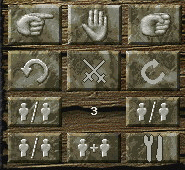 Soldier Menu |
This is a somewhat later revision of the soldier menu. The basic layout is the same as in the final version and the only difference is that some graphics are unfinished and the soldier formations are still specified by using numbers. |
Multiplayer
| Advanced Chatting System |
There were plans to implement a more advanced chatting system into the game. This system was supposed to allow you to set priorities to messages when sending them so that the player who received them would know whether it was something urgent and if it wasn't urgent, one could save it for later if busy doing something else. The urgency of the message was apparently supposed to affect the icon that is visible on a message that is received. |
| Multiplayer AI |
This is one of the most notable features that was dropped from the game. What is especially ironic is that the game was advertised as including AI support for multiplayer games even though this support was never finished. The AI was supposed to come in three difficulty levels, and it was also supposed to send you messages on occasion with varying content depending on how well you were doing and whether you were allies or weren't. |
Scenario Editor
Back when Joymania was creating the game they were using a map editor to hasten the process of making missions for them. According to TopWare Interactive, the editor was not released because of being too complicated, and on top of all, one had to script everything moving in the missions by hand.
Judging by the screenshot from the alpha version and the fact that suspicious graphics have been found from the game files, it would seem that the editor itself was pretty well integrated into the game itself. Below you can find the graphics that are thought to be remnants of the official map editor.
Mini-map |
This icon was probably used to enable the mini-map view to get a better grasp of the bigger picture. |
Collision |
This button was probably used to control the collision properties of tiles in the game. The game engine allows quite good customization of these properties. |
Brush |
This tool was most likely used to use the smart-tiling or brush feature of the editor to alter terrain in a fast manner. |
Elevation |
Looking at the icon is surely does resemble a cliff a lot, so this icons function was more than likely to change the elevation of the ground. It could most likely be used to create both canyons and cliffs. |
Map copy |
I'd be highly surprised if my bet would go wrong here. There are two identical pictures on top of each other, so it has to be... Map copy! I guess you had to choose an area you wanted to copy using this tool and then you could place an identical area somewhere else. |
Terrain |
This was likely used to enable the tool where you could place individual tiles. As the terrain set is limited in the amount of tiles, full blending between all terrain types is not possible and as such manual tile editing would be necessary. |
Forest |
Over here we have the icon that was likely used to place trees, bushes, rocks and other kinds of objects that would make the terrain seem more alive. |
Help |
Question marks usually display some kind of help or documentation file. While this could have been the case, I find it strange how there's a help button in an editor that was not supposed to be used by anyone else than the developers? Perhaps it is an indication of the fact that it was planned to be released, but sadly it never was. |
Save map |
A floppy disk is usually used for storing, right? I guess the developers were no different, so this had to be the button that allowed one to save the map currently being created. |
